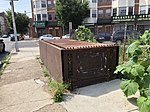Smaltz Building

Smaltz Building, also known as the Smaltz-Goodwin Building, is a historic factory building located in the Callowhill neighborhood of Philadelphia, Pennsylvania. It was built in 1911, and is a 10-story, 11 bay by five bay, reinforced concrete building. It originally housed the Smaltz-Goodwin women's shoe manufacturer until 1933, then a variety of clothing manufacturers.It was added to the National Register of Historic Places in 2005. It is a contributing property to the Callowhill Industrial Historic District. Between 2012 and 2016 the Post Brothers development company rehabbed the Smaltz Building into the first LEED Gold certified residential high-rise in Philadelphia, opening the building as The Goldtex apartment community in January 2016.
Excerpt from the Wikipedia article Smaltz Building (License: CC BY-SA 3.0, Authors, Images).Smaltz Building
Callowhill Street, Philadelphia Center City
Geographical coordinates (GPS) Address Phone number Nearby Places Show on map
Geographical coordinates (GPS)
| Latitude | Longitude |
|---|---|
| N 39.959722222222 ° | E -75.158333333333 ° |
Address
Callowhill Street 1201
19123 Philadelphia, Center City
Pennsylvania, United States
Open on Google Maps








